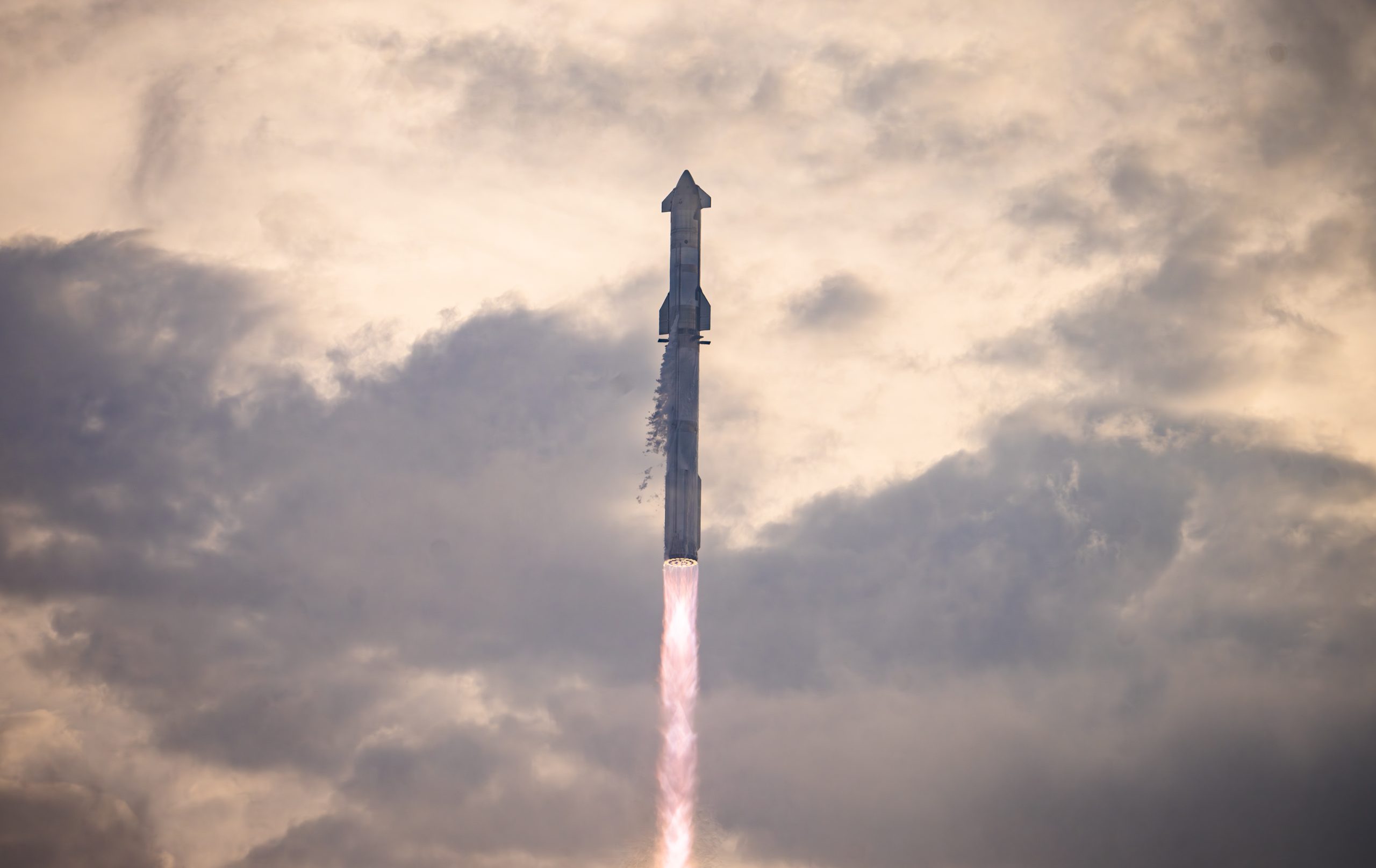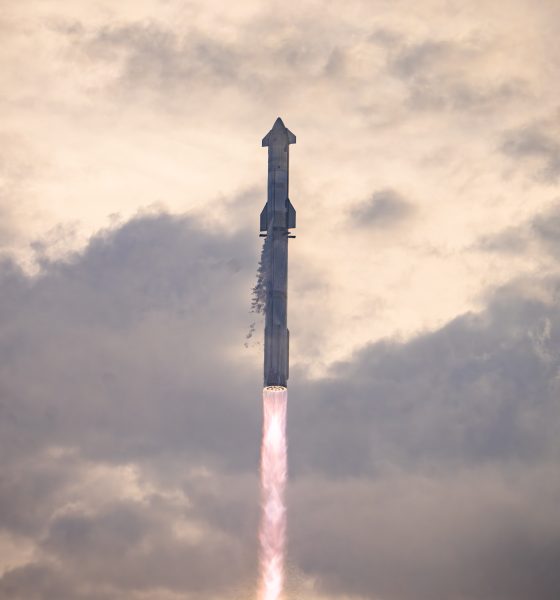

News
SpaceX successful in epic third Starship test launch
SpaceX was successful in its third test flight of the largest rocket ever as Starship took to the skies at 8:25 am CT from Starbase, Texas.
The massive rocket made it further than ever during its third flight, including successful stage separation and atmospheric re-entry.
Liftoff of Starship! pic.twitter.com/FaNcasuKaq
— SpaceX (@SpaceX) March 14, 2024
The 33 Raptor engines powered Booster 10 with Ship 28 stacked on top all the way through its portion of the flight, never losing one engine. Two minutes and 50 seconds into the flight, Booster 10 and Ship 28 went through the hot staging maneuver flawlessly.
Starship’s Raptor engines have ignited during hot-staging separation. Super Heavy is executing the flip maneuver pic.twitter.com/T593ACilyD
— SpaceX (@SpaceX) March 14, 2024
Booster 10 then relit some of its engines to perform the boost backburn toward a landing area just East of the launch pad in the Gulf of Mexico. The booster made it all the way through the burn and re-oriented itself to a vertical position as it plunged through the atmosphere and used its giant grid fins to help stabilize the vehicle.
During the final moments of the re-entry, the forces on the vehicle became too much, and around the 2 km mark, the booster engine attempted to light for the landing burn, but it appears a few failed, and the booster was lost shortly after.
While Booster 10 was plunging back through the atmosphere, Ship 28 continued to fly perfectly, burning all 6 Raptor engines to reach orbital velocity. The ships’ engines shut down just over eight and a half minutes into flight and were officially in space, coasting between the Florida Keys and Cuba on its way to its planned re-entry over the Indian Ocean.
Starship is coasting in space pic.twitter.com/ZFUXMUkufW
— SpaceX (@SpaceX) March 14, 2024
During the coast phase, SpaceX completed multiple in-flight tests, such as opening and closing the payload bay, or the pez door, as they put it. Following that, the rocket then performed a fuel transfer demonstration, moving fuel from the header tanks into the main tanks. This was the first time they had done this while in orbit, but according to Gwynne Shotwell, SpaceX’s president and COO, they are waiting to officially confirm this.
SpaceX had intended to perform a re-light of a Raptor engine while in space, however, they elected to skip that and attempt this during a future mission.
Pez door checkout complete, door closing, and HD views are over @Starlink pic.twitter.com/Kmb2SpMVTu
— SpaceX (@SpaceX) March 14, 2024
Ship 28 then began atmospheric entry 46 minutes into the mission. Thanks to the Starlink connection, SpaceX was able to provide amazing views of the plasma build-up around the ship, something that is generally never seen as the plasma blocks the signal on smaller vehicles.
Starship re-entering Earth’s atmosphere. Views through the plasma pic.twitter.com/HEQX4eEHWH
— SpaceX (@SpaceX) March 14, 2024
Just over 49 minutes into the flight, during peak heating, the Starship data connection was lost with both Starlink and TDRS (Tracking and Data Relay satellites), the former being used for all vehicles in space, including the Crew Dragon capsule.
The on-screen telemetry stopped at a speed of 25,707 km/h at a height of 65 km. SpaceX said that with both signals dropping at the same time, it is likely the ship broke up during re-entry and did not make the planned intact splashdown.
While neither Booster 10 nor Ship 28 made it 100% to their planned splashdown, this third test flight was a massive win for SpaceX, and the company will look to complete the fourth flight test within a couple of months.
Questions or comments? Shoot me an email at rangle@teslarati.com, or Tweet me @RDAnglePhoto.

News
Tesla starts showing how FSD will change lives in Europe
Local officials tested the system on narrow country roads and were impressed by FSD’s smooth, human-like driving, with some calling the service a game-changer for everyday life in areas that are far from urban centers.

Tesla has launched Europe’s first public shuttle service using Full Self-Driving (Supervised) in the rural Eifelkreis Bitburg-Prüm region of Germany, demonstrating how the technology can restore independence and mobility for people who struggle with limited transport options.
Local officials tested the system on narrow country roads and were impressed by FSD’s smooth, human-like driving, with some calling the service a game-changer for everyday life in areas that are far from urban centers.
Officials see real impact on rural residents
Arzfeld Mayor Johannes Kuhl and District Administrator Andreas Kruppert personally tested the Tesla shuttle service. This allowed them to see just how well FSD navigated winding lanes and rural roads confidently. Kruppert said, “Autonomous driving sounds like science fiction to many, but we simply see here that it works totally well in rural regions too.” Kuhl, for his part, also noted that FSD “feels like a very experienced driver.”
The pilot complements the area’s “Citizen Bus” program, which provides on-demand rides for elderly residents who can no longer drive themselves. Tesla Europe shared a video of a demonstration of the service, highlighting how FSD gives people their freedom back, even in places where public transport is not as prevalent.
What the Ministry for Economic Affairs and Transport says
Rhineland-Palatinate’s Minister Daniela Schmitt supported the project, praising the collaboration that made this “first of its kind in Europe” possible. As per the ministry, the rural rollout for the service shows FSD’s potential beyond major cities, and it delivers tangible benefits like grocery runs, doctor visits, and social connections for isolated residents.
“Reliable and flexible mobility is especially vital in rural areas. With the launch of a shuttle service using self-driving vehicles (FSD supervised) by Tesla in the Eifelkreis Bitburg-Prüm, an innovative pilot project is now getting underway that complements local community bus services. It is the first project of its kind in Europe.
“The result is a real gain for rural mobility: greater accessibility, more flexibility and tangible benefits for everyday life. A strong signal for innovation, cooperation and future-oriented mobility beyond urban centers,” the ministry wrote in a LinkedIn post.
News
Tesla China quietly posts Robotaxi-related job listing
Tesla China is currently seeking a Low Voltage Electrical Engineer to work on circuit board design for the company’s autonomous vehicles.

Tesla has posted a new job listing in Shanghai explicitly tied to its Robotaxi program, fueling speculation that the company is preparing to launch its dedicated autonomous ride-hailing service in China.
As noted in the listing, Tesla China is currently seeking a Low Voltage Electrical Engineer to work on circuit board design for the company’s autonomous vehicles.
Robotaxi-specific role
The listing, which was shared on social media platform X by industry watcher @tslaming, suggested that Tesla China is looking to fill the role urgently. The job listing itself specifically mentions that the person hired for the role will be working on the Low Voltage Hardware team, which would design the circuit boards that would serve as the nervous system of the Robotaxi.
Key tasks for the role, as indicated in the job listing, include collaboration with PCB layout, firmware, mechanical, program management, and validation teams, among other responsibilities. The role is based in Shanghai.
China Robotaxi launch
China represents a massive potential market for robotaxis, with its dense urban centers and supportive policies in select cities. Tesla has limited permission to roll out FSD in the country, though despite this, its vehicles have been hailed as among the best in the market when it comes to autonomous features. So far, at least, it appears that China supports Tesla’s FSD and Robotaxi rollout.
This was hinted at in November, when Tesla brought the Cybercab to the 8th China International Import Expo (CIIE) in Shanghai, marking the first time that the autonomous two-seater was brought to the Asia-Pacific region. The vehicle, despite not having a release date in China, received a significant amount of interest among the event’s attendees.
Elon Musk
Elon Musk and Tesla AI Director share insights after empty driver seat Robotaxi rides
The executives’ unoccupied tests hint at the rapid progress of Tesla’s unsupervised Robotaxi efforts.

Tesla CEO Elon Musk and AI Director Ashok Elluswamy celebrated Christmas Eve by sharing personal experiences with Robotaxi vehicles that had no safety monitor or occupant in the driver’s seat. Musk described the system’s “perfect driving” around Austin, while Elluswamy posted video from the back seat, calling it “an amazing experience.”
The executives’ unoccupied tests hint at the rapid progress of Tesla’s unsupervised Robotaxi efforts.
Elon and Ashok’s firsthand Robotaxi insights
Prior to Musk and the Tesla AI Director’s posts, sightings of unmanned Teslas navigating public roads were widely shared on social media. One such vehicle was spotted in Austin, Texas, which Elon Musk acknowleged by stating that “Testing is underway with no occupants in the car.”
Based on his Christmas Eve post, Musk seemed to have tested an unmanned Tesla himself. “A Tesla with no safety monitor in the car and me sitting in the passenger seat took me all around Austin on Sunday with perfect driving,” Musk wrote in his post.
Elluswamy responded with a 2-minute video showing himself in the rear of an unmanned Tesla. The video featured the vehicle’s empty front seats, as well as its smooth handling through real-world traffic. He captioned his video with the words, “It’s an amazing experience!”
Towards Unsupervised operations
During an xAI Hackathon earlier this month, Elon Musk mentioned that Tesla owed be removing Safety Monitors from its Robotaxis in Austin in just three weeks. “Unsupervised is pretty much solved at this point. So there will be Tesla Robotaxis operating in Austin with no one in them. Not even anyone in the passenger seat in about three weeks,” he said. Musk echoed similar estimates at the 2025 Annual Shareholder Meeting and the Q3 2025 earnings call.
Considering the insights that were posted Musk and Elluswamy, it does appear that Tesla is working hard towards operating its Robotaxis with no safety monitors. This is quite impressive considering that the service was launched just earlier this year.








